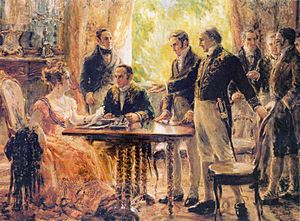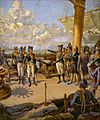José Bonifácio de Andrada e Silva facts for kids
Quick facts for kids
José Bonifácio de Andrada e Silva
|
|
|---|---|

Portrait by Oscar Pereira da Silva
|
|
| Secretary of State of Imperial Affairs Kingdom Affairs (Jan–Sep 1822) |
|
| In office 30 October 1822 – 17 July 1823 |
|
| Monarch | Pedro I |
| Preceded by | Baron of Santo Amaro |
| Succeeded by | José Joaquim Carneiro de Campos |
| In office 16 January 1822 – 28 October 1822 |
|
| Monarch | João VI Pedro I |
| Preceded by | Marcos de Noronha e Brito |
| Succeeded by | Baron of Santo Amaro |
| Secretary of State of Foreign Affairs | |
| In office 16 January 1822 – 16 July 1823 |
|
| Monarch | João VI Pedro I |
| Preceded by | Office established |
| Succeeded by | José Joaquim Carneiro de Campos |
| General Deputy | |
| In office 22 June 1831 – 6 October 1833 |
|
| Constituency | Bahia |
| In office 3 May 1823 – 12 November 1823 |
|
| Constituency | São Paulo |
| Personal details | |
| Born | 13 June 1763 Santos, São Paulo, State of Brazil, Portuguese America |
| Died | 6 April 1838 (aged 74) Niterói, Rio de Janeiro, Empire of Brazil |
| Spouse |
Narcisa Emília O'Leary
(m. 1790; died 1829) |
| Children | 3 |
| Parents |
|
| Alma mater | University of Coimbra |
| Signature | |
José Bonifácio de Andrada e Silva (born June 13, 1763 – died April 6, 1838) was a very important person in Brazil's history. He was a politician, a scientist who studied nature and minerals, a professor, and a poet. He was born in Santos, which was part of the Portuguese Empire back then.
José Bonifácio was one of the main people who helped Brazil become independent from Portugal. His actions were very important for Emperor Pedro I to succeed. He believed in good public education for everyone. He also wanted to end slavery. He even suggested building a new capital city in the middle of Brazil, which later happened with Brasília. As a scientist, he found four new minerals.
Contents
His Amazing Life
In 1800, José Bonifácio became a professor of geology at the University of Coimbra in Portugal. Soon after, he became the main inspector of Portuguese mines. In 1812, he was made a permanent secretary of the Lisbon Academy of Sciences.
He came back to Brazil in 1819. He told Prince Pedro to stand up to the Portuguese court. In 1821, he became one of Pedro's ministers. When Brazil declared its independence, José Bonifácio became the minister for internal and foreign affairs. He was also chosen by the Constituent Assembly. He wrote a plan to end slavery in Brazil, which he showed to the Assembly in 1823. But because he believed in democratic ideas, he was removed from his job in July 1823.
His Time in Europe
José Bonifácio spent a big part of his life traveling and studying in Europe. He studied chemistry and mineralogy with other scientists. He collected information, did experiments, and discovered four new minerals. He also found eight types of plants or animals that no one knew about before. The mineral andradite is named after him.
One of his discoveries was petalite. This mineral contains lithium. He found it in Sweden in the late 1700s. Swedish chemists later discovered lithium in this mineral. He also found another important lithium-containing mineral called spodumene in Sweden.
In 1797, he became a foreign member of the Royal Swedish Academy of Sciences.
José Bonifácio earned degrees in Law and Natural Philosophy from the University of Coimbra. He joined the Lisbon Academy of Sciences and taught Geognosy (the study of the Earth's structure) at the University of Coimbra. He knew twelve languages and could speak four of them.
Coming Back to Brazil
In 1819, José Bonifácio returned to Brazil. He kept doing his scientific research there. He was a very smart and strong-willed person. He was also made Minister for Kingdom and Overseas Affairs, which meant he was like the prime minister.

His relationship with Prince Pedro became difficult, so he joined the group that opposed the government. In 1823, he was sent away from Brazil and went to live in Bordeaux, France. In 1825, he published a book of poems called "Poesias Avulsas" (Sundry Poetries) using the pen name Américo Elísio. When the Assembly was closed in November (known as the Night of Agony), he was arrested and sent to France. He lived in exile near Bordeaux until 1829, when he was allowed to come back to Brazil.
In 1831, when Dom Pedro I gave up his throne, he asked José Bonifácio to be the teacher for his son, the future Emperor. José Bonifácio did not agree with the new government that was ruling Brazil. He tried to bring back the Empire. He was arrested again in 1833 and accused of trying to help Dom Pedro I. After that, he spent the rest of his life quietly in Niterói. He lost his job as a tutor and was called a traitor, but he was later forgiven.
In December 1836, he became sick with tuberculosis. He died from the illness on April 6, 1838, in Niterói.
His Love for Writing
José Bonifácio also enjoyed writing. His book Poesias Avulsas, first published in Bordeaux, was re-published in Brazil in 1861. It was simply called "Poesias" (Poetries). In 1942, another version was prepared by the Brazilian Academy of Letters. This work was also part of a collection in 1946, called Poesias de Américo Elísio. His poems show his love for nature and his scientific curiosity.
His scientific, political, and social writings are in another book. This book was published in 1963 to celebrate 200 years since his birth. He is known as the "Patriarch of the Independence" of Brazil.
The mineral andradite was named after José Bonifácio to honor him.
Images for kids
-
Prince Regent Pedro of Braganza (pointing) with José Bonifácio (in civilian clothes) and others on a ship in 1822.
-
The Founding of the Brazilian Fatherland, a painting from 1899 showing José Bonifácio with the imperial flag and different groups of people in Brazil.
Monuments to José Bonifácio
-
Statue in Rio de Janeiro.
-
Statue at the Monument to the Independence of Brazil in São Paulo.
-
Monument to the Andrada brothers in Santos.
-
Statue at Bryant Park in Manhattan, New York City.
See also
 In Spanish: José Bonifácio de Andrada e Silva para niños
In Spanish: José Bonifácio de Andrada e Silva para niños
- Statue of José Bonifácio de Andrada












